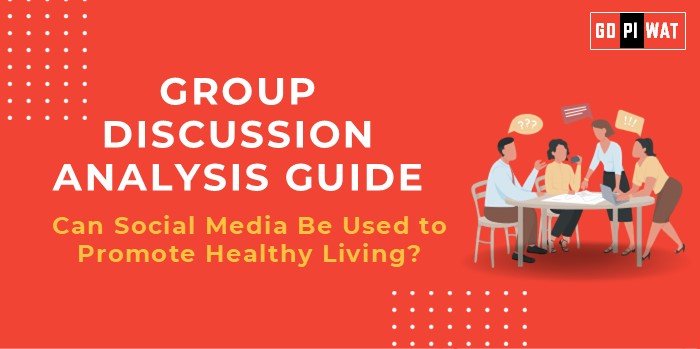📋 Group Discussion (GD) Analysis Guide: Can Social Media Be Used to Promote Healthy Living?
🌐 Introduction to the Topic
Opening Context: Social media platforms have transformed how individuals access information, interact, and share ideas. With billions of users globally, they hold immense potential to influence lifestyles, including health-related behaviors.
Topic Background: The rise of platforms like Instagram, TikTok, and YouTube has ushered in an era where influencers, healthcare professionals, and organizations can disseminate information on fitness, nutrition, mental health, and disease prevention. However, their effectiveness and ethical implications remain subjects of debate.
📊 Quick Facts and Key Statistics
- 🌍 Global Social Media Users: 4.8 billion (2024) – A vast audience for health promotion.
- 📸 Fitness Hashtags on Instagram: Over 400 million posts – Illustrates high engagement with health topics.
- 📱 Health App Integration: 60% of fitness app users share progress via social media – Bridging technology with lifestyle changes.
- 🌐 WHO Campaign Reach (2023): Over 500 million engagements – Demonstrates the impact of structured health initiatives on platforms.
👥 Stakeholders and Their Roles
- 🩺 Healthcare Organizations: Provide accurate, science-backed information.
- 🤳 Influencers: Act as intermediaries in promoting health and wellness trends.
- 🏛️ Policy Makers: Regulate misinformation and ensure compliance with health standards.
- 👥 General Public: Consumers of content who adapt behaviors based on shared knowledge.
🏆 Achievements and Challenges
Achievements:
- 🌍 Widespread Reach: Campaigns like WHO’s #HealthForAll achieved global visibility.
- 💪 Behavioral Impact: Studies show increased exercise rates linked to motivational content online.
- 🧠 Awareness Creation: Topics like mental health destigmatization have gained traction.
- 🤝 Community Support: Virtual fitness communities encourage sustained health habits.
Challenges:
- ⚠️ Misinformation: Prevalence of unverified health advice.
- 🧠 Mental Health Risks: Unrealistic body image standards leading to issues like anxiety.
- 📉 Accessibility Gap: Limited reach among non-digital users.
- 💰 Commercialization: Brands prioritizing profit over accurate information.
🌏 Global Comparisons:
- 🇩🇰 Success: Denmark’s government health campaigns on social media reported a 25% increase in public participation in fitness programs.
- 🇺🇸 Challenges: U.S. platforms face criticism for allowing unregulated wellness products.
📖 Case Studies:
India: #FitIndiaMovement utilized platforms like Twitter and Instagram to promote physical activities.
📚 Structured Arguments for Discussion
- ✅ Supporting Stance: “Social media’s extensive reach has transformed health promotion by engaging diverse demographics and amplifying positive behaviors.”
- ❌ Opposing Stance: “The risks of misinformation and the commercialization of health campaigns often undermine their credibility and impact.”
- ⚖️ Balanced Perspective: “While social media enables health awareness, its impact is contingent on regulation, credible content, and user engagement.”
🎯 Effective Discussion Approaches
- 💡 Opening Approaches:
- Data Introduction: “With 4.8 billion users globally, social media offers unprecedented reach for health promotion.”
- Case Study Highlight: “Denmark’s successful social media health campaigns demonstrate its potential.”
- Contrast Approach: “While social media raises awareness, misinformation presents a significant barrier.”
- 🛠️ Counter-Argument Handling: Acknowledge the issue of misinformation and suggest solutions like platform regulation and partnerships with health organizations.
🔍 Strategic Analysis of Strengths and Weaknesses
Strengths:
- 🌍 Global reach
- 💸 Cost-effectiveness
- 🤝 Community building
Weaknesses:
- 📣 Spread of misinformation
- 📉 Digital divide
Opportunities:
- 🤖 AI-based content moderation
- 🤝 Partnerships with credible organizations
Threats:
- ⚖️ Regulatory challenges
- 🔒 Privacy concerns
🎓 Connecting with B-School Applications
- 🌟 Real-World Applications: Projects on leveraging social media for CSR health campaigns.
- 📖 Case studies: Analyzing the impact of influencer-led health initiatives.
- ❓ Sample Interview Questions:
- “How can social media complement traditional health promotion methods?”
- “Evaluate the role of influencers in shaping public health awareness.”
- 📘 Insights for Students: Explore social media’s intersection with healthcare marketing. Assess the ethical dimensions of digital health promotion.


